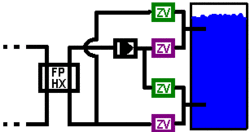I know this topic has been discussed, especially by Sparke, but I don't there has been a concensus (at least not from my perspective)
I am getting my Tarm 60 next week. I'm in the process of finalizing my tank design and was hoping to ask you a few questions. I am thinking about going with pex or copper over the flat plate for several reasons. It is one less pump on both sides. Less chance of something going wrong (Hx failure or pump failure). I don't have to install water tight holes in the side of the tank. Also, after adding the price of the electric for the pump and some other components to run all the pumps, the flat plate HX adds up quickly.
Obviously, going copper is very expensive and I don't want to spend the money on soft copper or going to the hassle of making a hard copper HX.
So that leaves me with pex. I'm thinking of doing 2 separate HX's - one for the heat input (on the bottom of the tank) and one for the output (top of tank). The Tarm 60 is rated at 198K BTU's. I am thinking of using about 1000-1500 1/2 inch pex at 200 foot lengths each. Sound right?
For the output, I'm wondering if I can get away with less. I need to extract 80K BTU. Since I have radiant heat floor I only plan on having a 10 temp drop. My concern is when the return temp is 90 and I need to raise the water supply water to 100 and the water in my tank is only 105. I suppose the answer is always that I could add more pex. But am I better off with more shorter runs, or fewer longer runs. It appears to me that the longer the water runs through the PEX while in the tank, the greater the chance it will rise to the desired temperature.
Sparke - I know you have had success with Pex, but also indicated you'd go with the FP HX if you were to do it again. Is it only because of the labor in putting them together? What is your boiler rated at? Do you wish you used more pex?
Any thoughts or help is greatly appreciated.
I am getting my Tarm 60 next week. I'm in the process of finalizing my tank design and was hoping to ask you a few questions. I am thinking about going with pex or copper over the flat plate for several reasons. It is one less pump on both sides. Less chance of something going wrong (Hx failure or pump failure). I don't have to install water tight holes in the side of the tank. Also, after adding the price of the electric for the pump and some other components to run all the pumps, the flat plate HX adds up quickly.
Obviously, going copper is very expensive and I don't want to spend the money on soft copper or going to the hassle of making a hard copper HX.
So that leaves me with pex. I'm thinking of doing 2 separate HX's - one for the heat input (on the bottom of the tank) and one for the output (top of tank). The Tarm 60 is rated at 198K BTU's. I am thinking of using about 1000-1500 1/2 inch pex at 200 foot lengths each. Sound right?
For the output, I'm wondering if I can get away with less. I need to extract 80K BTU. Since I have radiant heat floor I only plan on having a 10 temp drop. My concern is when the return temp is 90 and I need to raise the water supply water to 100 and the water in my tank is only 105. I suppose the answer is always that I could add more pex. But am I better off with more shorter runs, or fewer longer runs. It appears to me that the longer the water runs through the PEX while in the tank, the greater the chance it will rise to the desired temperature.
Sparke - I know you have had success with Pex, but also indicated you'd go with the FP HX if you were to do it again. Is it only because of the labor in putting them together? What is your boiler rated at? Do you wish you used more pex?
Any thoughts or help is greatly appreciated.


